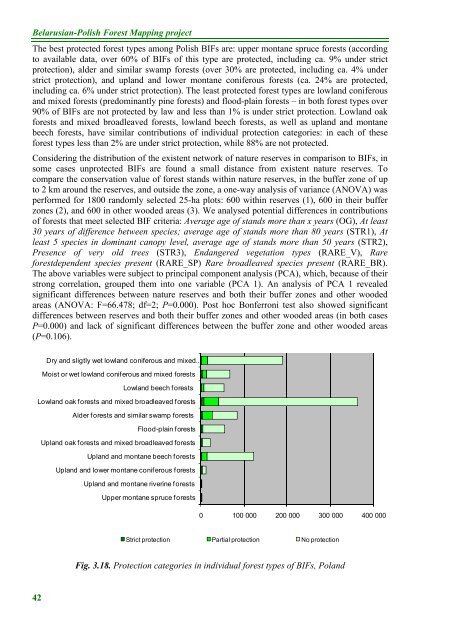Belarusian Polish Forest Mapping Belarusian Polish Forest Mapping
Belarusian Polish Forest Mapping Belarusian Polish Forest Mapping
Belarusian Polish Forest Mapping Belarusian Polish Forest Mapping
Create successful ePaper yourself
Turn your PDF publications into a flip-book with our unique Google optimized e-Paper software.
<strong>Belarusian</strong>-<strong>Polish</strong> <strong>Forest</strong> <strong>Mapping</strong> project<br />
The best protected forest types among <strong>Polish</strong> BIFs are: upper montane spruce forests (according<br />
to available data, over 60% of BIFs of this type are protected, including ca. 9% under strict<br />
protection), alder and similar swamp forests (over 30% are protected, including ca. 4% under<br />
strict protection), and upland and lower montane coniferous forests (ca. 24% are protected,<br />
including ca. 6% under strict protection). The least protected forest types are lowland coniferous<br />
and mixed forests (predominantly pine forests) and flood-plain forests – in both forest types over<br />
90% of BIFs are not protected by law and less than 1% is under strict protection. Lowland oak<br />
forests and mixed broadleaved forests, lowland beech forests, as well as upland and montane<br />
beech forests, have similar contributions of individual protection categories: in each of these<br />
forest types less than 2% are under strict protection, while 88% are not protected.<br />
Considering the distribution of the existent network of nature reserves in comparison to BIFs, in<br />
some cases unprotected BIFs are found a small distance from existent nature reserves. To<br />
compare the conservation value of forest stands within nature reserves, in the buffer zone of up<br />
to 2 km around the reserves, and outside the zone, a one-way analysis of variance (ANOVA) was<br />
performed for 1800 randomly selected 25-ha plots: 600 within reserves (1), 600 in their buffer<br />
zones (2), and 600 in other wooded areas (3). We analysed potential differences in contributions<br />
of forests that meet selected BIF criteria: Average age of stands more than x years (OG), At least<br />
30 years of difference between species; average age of stands more than 80 years (STR1), At<br />
least 5 species in dominant canopy level, average age of stands more than 50 years (STR2),<br />
Presence of very old trees (STR3), Endangered vegetation types (RARE_V), Rare<br />
forestdependent species present (RARE_SP) Rare broadleaved species present (RARE_BR).<br />
The above variables were subject to principal component analysis (PCA), which, because of their<br />
strong correlation, grouped them into one variable (PCA 1). An analysis of PCA 1 revealed<br />
significant differences between nature reserves and both their buffer zones and other wooded<br />
areas (ANOVA: F=66.478; df=2; P=0.000). Post hoc Bonferroni test also showed significant<br />
differences between reserves and both their buffer zones and other wooded areas (in both cases<br />
P=0.000) and lack of significant differences between the buffer zone and other wooded areas<br />
(P=0.106).<br />
Dry and sligtly wet lowland coniferous and mixed …<br />
Moist or wet lowland coniferous and mixed forests<br />
Lowland beech forests<br />
Lowland oak forests and mixed broadleaved forests<br />
Alder forests and similar swamp forests<br />
Flood-plain forests<br />
Upland oak forests and mixed broadleaved forests<br />
Upland and montane beech forests<br />
Upland and lower montane coniferous forests<br />
Upland and montane riverine forests<br />
Upper montane spruce forests<br />
0 100 000 200 000 300 000 400 000<br />
Strict protection Partial protection No protection<br />
Fig. 3.18. Protection categories in individual forest types of BIFs, Poland<br />
42

















